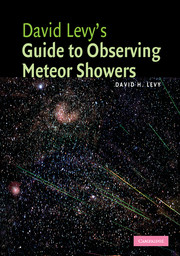Book contents
- Frontmatter
- Contents
- Preface
- 1 July 4, 1956
- 2 What is a meteor?
- 3 Some historical notes
- 4 Small rocks and dust in space
- 5 Observing meteors
- 6 Recording meteors
- 7 A New Year gift: the Quadrantids
- 8 The Lyrids – an April shower
- 9 The Eta Aquarids
- 10 The Omicron Draconids, continued
- 11 The Delta Aquarids
- 12 Tears of St. Lawrence: Perseid trails and trials
- 13 The August Pavonids
- 14 The Orionids
- 15 The Taurids
- 16 The Leonids
- 17 The Geminids
- 18 The Ursids
- 19 A catalog of meteor showers throughout the year
- Appendix
- Index
17 - The Geminids
Published online by Cambridge University Press: 06 July 2010
- Frontmatter
- Contents
- Preface
- 1 July 4, 1956
- 2 What is a meteor?
- 3 Some historical notes
- 4 Small rocks and dust in space
- 5 Observing meteors
- 6 Recording meteors
- 7 A New Year gift: the Quadrantids
- 8 The Lyrids – an April shower
- 9 The Eta Aquarids
- 10 The Omicron Draconids, continued
- 11 The Delta Aquarids
- 12 Tears of St. Lawrence: Perseid trails and trials
- 13 The August Pavonids
- 14 The Orionids
- 15 The Taurids
- 16 The Leonids
- 17 The Geminids
- 18 The Ursids
- 19 A catalog of meteor showers throughout the year
- Appendix
- Index
Summary
My lord, do you see these meteors? do you behold these exhalations?
During the autumn of 1983, planetary scientist Clark Chapman and I were observing asteroids from Kitt Peak, the U.S. National Observatory in southern Arizona. As we recorded the magnitudes of each of our asteroids during the night, Clark told me of the discovery of a three-mile wide asteroid called 1983 TB, an asteroid that seems to share the orbit of the Geminid stream. The major shower of the year, the Geminids would also be the most famous if the maximum were not during the bitter cold of winter in the northern hemisphere. But when the sky is clear, a bright, slow moving Geminid fireball crossing the sky is truly one of nature's most awesome sights. If this new object is the parent, the Geminids would be even more interesting. Moreover, would there be a chance that this object, now known as asteroid 3200 Phaethon, become the “mother of all Geminids” and collide with the Earth someday? Or could its orbit change so that, in a century or so, we won't even see the Geminids any more?
Phaethon was discovered in Draco on October 11, 1983 by John Davies and Simon Green, using IRAS (the Infrared Astronomical Satellite). The object, first known tentatively as 1983 TB until it received its permanent designation as 3200 Phaethon, was moving in an orbit so closely matched to the orbit of the Geminid stream that it was obvious that the parent had at last been found.
- Type
- Chapter
- Information
- David Levy's Guide to Observing Meteor Showers , pp. 96 - 99Publisher: Cambridge University PressPrint publication year: 2007



